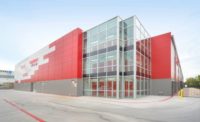The retrofit of Lafayette College’s Bushkill Commons is an example of adaptive building reuse, utilizing sustainable design, products and energy efficiency. ATAS’ Isoleren insulated metal wall panels were incorporated into the building to help achieve those objectives. Earlier this year, the building was nominated for a Lehigh Valley Sustainability Award by the Lehigh Valley branch of the Delaware Valley Green Building Council.
The historic Hummel Lumber Building had fallen into disrepair and was converted to new office space for Lafayette College Facilities Plant Operations/Planning & Construction Departments, as well as the Public Safety and Environmental Health and Safety Department. Originally built by the Speer Lumber Company of Easton in the early 1900s, and later occupied by the Hummel Lumber Company, the original post and beam structure wrapped in a masonry facade had survived a few fires and the wrecking ball. Located at the edge of College Hill, it was an ideal building for Lafayette's expansion and the College's desire to contribute to the revitalization of Easton.
As shared by Marie Fechik-Kirk, Director of Sustainability for Lafayette College, the reuse of the existing building posed many challenges including restoring the fire damaged wood structure as well as understanding the impact of insulating and conditioning the interior of the building. The existing posts and beams were covered and the full extent of the fire damage was unknown. All existing timbers and structural decking was exposed and assessed for structural integrity. The exposed timbers were cleaned with a combination of dry ice and media blasting to remove charring and odor. Basement posts were replaced with steel columns and footings which allowed for leveling of the upper three floors from below. Some portions of existing timbers and flooring were replaced. The end product maintained the original exposed post and beam character throughout the original building.
Careful consideration was given to the impact of insulating and conditioning this building as it was historically an open structure. The masonry facade is original reinforced units with minimal tiebacks and no expansion joints. To maintain the ability for the masonry to dry from both sides, an interior rain screen wall was created to allow for a continuous air space from foundation masonry vents up to the soffit line. Interior insulated wall panels were built, waterproofed with a breathable liquid membrane, and installed from the interior of the building. Existing window openings were detailed for flashing and maintaining the continuous airspace while allowing reinforcement of the masonry facade by tying to the interior wall system. The installed system will maintain the cycle of the existing building while allowing for a comfortable interior work space.
Every room of the building has been equipped with motion sensors for lighting control to continue the college’s efforts to reduce the campus’s carbon footprint. To facilitate egress, two additions housing the stairs and elevators were detailed to complement the existing structure while maintaining their own identity. The original building is easily identifiable. The construction stands separate but does not overwhelm the existing. The ATAS Isoleren insulated metal wall panels were installed in these additions, that are unconditioned spaces. Therefore, the insulating properties of the Isoleren panels assists in keeping the spaces at a comfortable level when occupants and visitors access them to move between the building levels.
For both retrofit of an older building, or construction of a new building, ATAS Isoleren insulated metal roof and wall panels can save costs in materials and labor, due to their single-unit composition and quick installation. Isoleren also provides superior insulating properties with design flexibility in a variety of colors, finishes and profiles.







